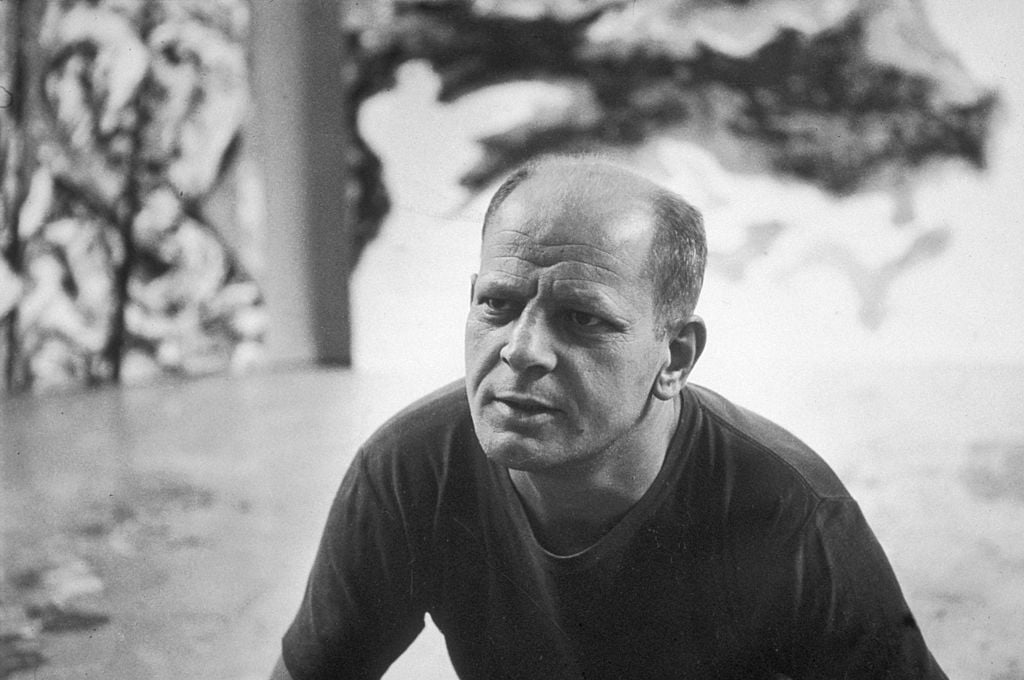
What’s the deal with Leonardo’s harpsichord-viola? Why were Impressionists obsessed with the color purple? Art Bites brings you a surprising fact, lesser-known anecdote, or curious event from art history. These delightful nuggets shed light on the lives of famed artists and decode their practices, while adding new layers of intrigue to celebrated masterpieces.
You’d be hard-pressed to find two characters in art history with less chemistry than Jackson Pollock and his patron, Peggy Guggenheim. The pair helped to pioneer contemporary American art as we know it without a single amorous exchange. In fact, when art critic Clement Greenberg called Guggenheim to report Pollock’s death, she responded, “I don’t give a damn.” But that’s not to say that they didn’t make memories along the way. Later on, she’d call Pollock her greatest achievement. And who could forget the time he peed in her fireplace?
While often repeated (and even immortalized in Ed Harris’s 2000 biopic Pollock), the anecdote has never been corroborated, and doesn’t appear in her memoir. It allegedly went down at her recently acquired East 61st Street duplex during a party around the installation of Pollock’s Mural (1943), his first commission from Guggenheim, and his most sprawling painting by that point—a work so potent it launched his career.
Jackson Pollock, Mural (1943). Courtesy of the University of Iowa.
Marcel Duchamp purportedly advised Guggenheim to commission the work, which didn’t quite fit into her foyer upon its arrival. “While Pollock went upstairs to get lost in Guggenheim’s liquor supply, the ever-helpful Duchamp calmly proposed cutting eight inches off one end,” Claudia Pierpont wrote. “The story of the victorious mural installation ends, rather famously, with Pollock wandering into a party at Guggenheim’s apartment later that night and peeing into the fireplace.” Apparently, he was even naked while doing it.
Why would an heiress tolerate such a display? Well, Guggenheim had seen worse by then. She carried the childhood trauma of her father’s death aboard the Titanic all her life. Her beloved older sister Benita perished in childbirth when Guggenheim was in her late 20s, living among artists in Europe. She watched hotels turn her Jewish family away more than once growing up. Guggenheim’s first husband abused her intensely, even rubbing jam in her hair, and the lover that followed called her “dog nose.” Bohemian society, as she knew it, didn’t have much time for politesse. What’s a little piss in light of all that?
Peggy Guggenheim. Photo via Youtube.
What’s more, Guggenheim regarded Pollock as her “spiritual offspring.” No other artist received the same support she offered him. By 1943, Guggenheim was in her prime. The year before, she opened her gallery Art of this Century at 30 West 57th Street. Pollock and his cohort created trailblazing new American paintings, Guggenheim presented them to the public, and Clement Greenberg taught everyone how to read them.
Pollock didn’t have the most pleasant life either. The noted alcoholic was born to a family so poor that his father was possibly even sold into farm labor himself as a child. Pollock suffered from volatile depression and had affairs. His mistress’s best friend died in the same drunk driving accident that killed him. Some believe that a curse follows him. If Pollock didn’t like a client, legend has it that he’d pee on a painting before giving it to them, too. He notably inspired Warhol’s mocking “Piss, Oxidation, and Cum” series decades later. Perhaps, on that night at Guggenheim’s apartment, Pollock was urinating on the concept of the party, or maybe he was just wasted. At any rate, Mural became a masterpiece, toured the world, and got a makeover before re-assuming its throne at the University of Iowa.